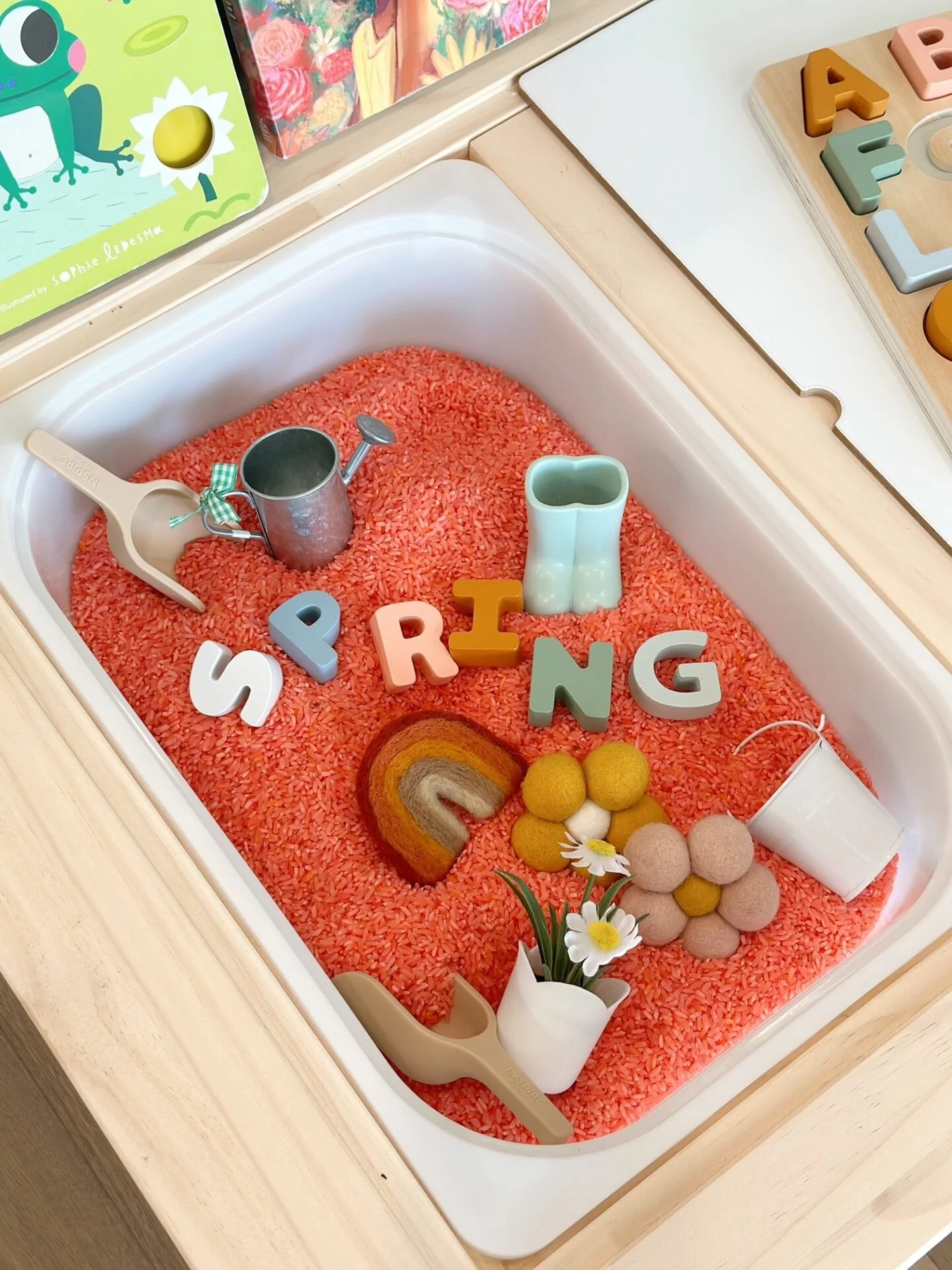A Quick and Easy Springtime Sensory Bin for Littles
Working with our hands- a fun way to learn!
Therapy comes in many forms, and one of the approaches that Katie at As We Speak uses is the use of sensory bins! These are fun, usually pretty small, bins- as the name suggests- that have exploratory things inside. You can choose from a number of things to put inside of the bin- like rice, beads, tiny objects, feathers, bouncy balls, bumpy or smooth toys, etc. It’s also good to put things like little scoopers or buckets in so kids can pick up and put the objects into something.
This seems simple, yes? Well, under the surface of what’s going on here is quite complex. Sensory bins are an excellent method of therapy for a few reasons.
It’s fun, so kids like to do it, and they almost immediately feel comfortable
They practice fine and gross motor skills like scooping, feeling, moving, and digging through objects.
They can practice Receptive and Expressive language skills - here’s more on this topic!
Kids usually talk about what they see, or you can get them to talk about what they see or feel. It builds curiosity, confidence, and exploration synapses in their brains.
The best part about sensory bins is that they can be modified pretty easily, so you can change up the things inside without too much effort. For example, you could add some blue beads for a springtime rain theme, some cotton balls (clouds), yellow noodles that look like lightning bolts, rainbow erasers, pipe cleaners that look like tornadoes, or pom pom balls for more clouds. While the children play in the sensory bin, you can talk about the weather and show things that they are looking at and compare them to the topic at hand- ie. Grab a pom pom and a cotton ball and talk about different types of clouds.
Learning through sensory bins is a fun, interactive tool used in speech and language therapy.
Kids can practice fine and gross motor skills like scooping, feeling, moving, and digging through objects.
To transition to a “summery vibe”, you could take out the beads, and put in sand for the base. Leave the yellow noodles, but this time they represent the sun! Pipe cleaners change shape, so you can change them to look like flowers! Pom pom balls can represent a beach ball instead of a cloud. All of the sudden, you’ve got new things to teach and the children can use their imagination while you’re at it.
Check out the sample Springtime sensory bin here:
The Spring bin has cute felt flowers, pink-dyed rice, rainbows, scoops, a watering can, and more. It’s simple, but so effective. Check out www.styldgrace.com- they have so many great examples of sensory bins and they are so cute!
Don’t have time or want to spend much on it? No worries.
Walk around your house and gather things with different textures, colors, sizes, or meaning.
Next, grab a bin- a shoebox, bowl, bucket, or even a small Tupperware container will do.
Look for these household items for inspiration:
-popcorn kernels
-rice
-noodles
-water
-paper- Cut it up into different shapes and use different colors if available.
-erasers
-magnets
-ice (I wouldn’t suggest mixing this with much else, though.)
-glitter
-sprinkles (a kid fave!)
-artificial flowers
-foil (make it into balls)
-puzzle pieces
-blocks
-flash cards- study letters and numbers while they play!
-eggs- plastic for Easter themed bins!
Get creative!
Don’t feel like you HAVE to include certain things in your sensory bin- it’s a exploritory opportunity for you and your child to explore!
The possibilities are endless here! You could create one specifically for color matching, alphabet learning, or counting. Or, you could keep it simple and just let their tiny hands explore textures! No matter the purpose, something will be gained from playing with a sensory bin- even if you can't see it.
This is why Katie loves to integrate the use of sensory bins when working with kiddos. Conversations start, they feel comfortable, and they get to have fun while doing it. On top of that, many things can be discovered:
Receptive Language goals:
Ability to follow directions. When pairing a book with a sensory bin, an SLP can ask the child to follow directions by looking for a character or other item within.
Understanding size concepts
Finding things that are the same or different
Understanding quantitative concepts- the most or the least amounts of something
Understanding qualitative Concepts- which items have various features like spots, bumps, or smooth
Expressive language goals:
Answering “who” questions.
Being able to use plurals of something
Answering “where” questions
Retelling stories when paired with a book and using figures to do so
Ability to build sentences
Creating a story
Describing items in the bin or playing “I Spy”
Social and play goals:
Understanding of taking turns
Being flexible
Realizing spatial concepts-placing things in certain spots
Targeting speech sounds
So this sounds great, but you’re not sure where to start?
That’s easy. Connect with us and we can set up a time for your child to meet Katie and to utilize our sensory bins!
Check out our socials this week for inspiration in the meantime!



